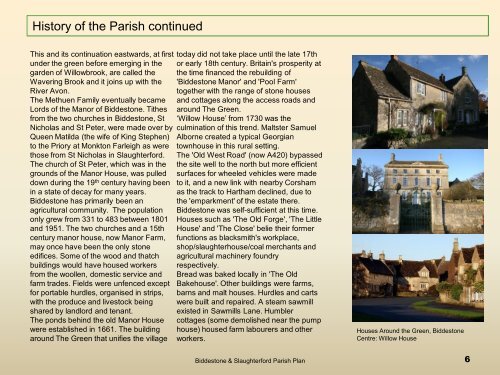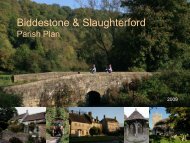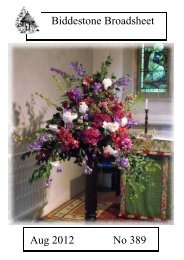Grant Proposal for Project Name - Biddestone Village
Grant Proposal for Project Name - Biddestone Village
Grant Proposal for Project Name - Biddestone Village
Create successful ePaper yourself
Turn your PDF publications into a flip-book with our unique Google optimized e-Paper software.
History of the Parish continued<br />
This and its continuation eastwards, at first<br />
under the green be<strong>for</strong>e emerging in the<br />
garden of Willowbrook, are called the<br />
Wavering Brook and it joins up with the<br />
River Avon.<br />
The Methuen Family eventually became<br />
Lords of the Manor of <strong>Biddestone</strong>. Tithes<br />
from the two churches in <strong>Biddestone</strong>, St<br />
Nicholas and St Peter, were made over by<br />
Queen Matilda (the wife of King Stephen)<br />
to the Priory at Monkton Farleigh as were<br />
those from St Nicholas in Slaughter<strong>for</strong>d.<br />
The church of St Peter, which was in the<br />
grounds of the Manor House, was pulled<br />
down during the 19 th century having been<br />
in a state of decay <strong>for</strong> many years.<br />
<strong>Biddestone</strong> has primarily been an<br />
agricultural community. The population<br />
only grew from 331 to 483 between 1801<br />
and 1951. The two churches and a 15th<br />
century manor house, now Manor Farm,<br />
may once have been the only stone<br />
edifices. Some of the wood and thatch<br />
buildings would have housed workers<br />
from the woollen, domestic service and<br />
farm trades. Fields were unfenced except<br />
<strong>for</strong> portable hurdles, organised in strips,<br />
with the produce and livestock being<br />
shared by landlord and tenant.<br />
The ponds behind the old Manor House<br />
were established in 1661. The building<br />
around The Green that unifies the village<br />
today did not take place until the late 17th<br />
or early 18th century. Britain's prosperity at<br />
the time financed the rebuilding of<br />
'<strong>Biddestone</strong> Manor' and 'Pool Farm'<br />
together with the range of stone houses<br />
and cottages along the access roads and<br />
around The Green.<br />
„Willow House‟ from 1730 was the<br />
culmination of this trend. Maltster Samuel<br />
Alborne created a typical Georgian<br />
townhouse in this rural setting.<br />
The 'Old West Road' (now A420) bypassed<br />
the site well to the north but more efficient<br />
surfaces <strong>for</strong> wheeled vehicles were made<br />
to it, and a new link with nearby Corsham<br />
as the track to Hartham declined, due to<br />
the 'emparkment' of the estate there.<br />
<strong>Biddestone</strong> was self-sufficient at this time.<br />
Houses such as 'The Old Forge', 'The Little<br />
House' and 'The Close' belie their <strong>for</strong>mer<br />
functions as blacksmith's workplace,<br />
shop/slaughterhouse/coal merchants and<br />
agricultural machinery foundry<br />
respectively.<br />
Bread was baked locally in 'The Old<br />
Bakehouse'. Other buildings were farms,<br />
barns and malt houses. Hurdles and carts<br />
were built and repaired. A steam sawmill<br />
existed in Sawmills Lane. Humbler<br />
cottages (some demolished near the pump<br />
house) housed farm labourers and other<br />
workers.<br />
<strong>Biddestone</strong> & Slaughter<strong>for</strong>d Parish Plan<br />
Houses Around the Green, <strong>Biddestone</strong><br />
Centre: Willow House<br />
6






